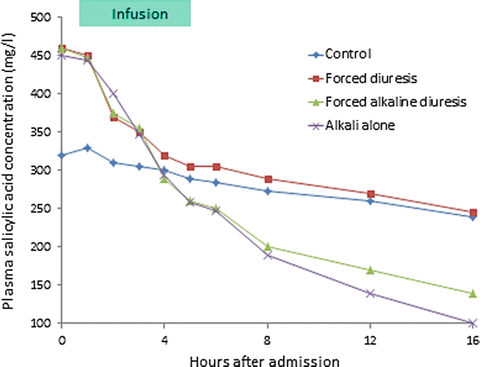2.
Increasing elimination (by manipulating urine pH, or by extracorporeal techniques)
(a)
Alkalinization of urine – weak acids like salicylates and barbiturates, ionize in alkaline urine resulting in an increase in their renal excretion (Fig. 27.1). Sodium bicarbonate is administered as IV bolus or infusion to maintain the urinary pH between 7.5 and 8.5. Continuous infusion is adjusted to clinical response or until serum pH is maintained between 7.50 and 7.55. This procedure is contraindicated in hypokalemia, and in those with renal insufficiency (not able to tolerate volume or sodium load).
(b)
Acidification of urine – Basic drugs like amphetamines, quinine, ephedrine and flecainide, ionize in acidic urine and are excreted more readily. Urine acidifiers include ammonium chloride and vitamin C.
(c)
Non-pharmacological approaches – peritoneal dialysis or hemodialysis can increase the elimination of salicylates, lithium, barbiturates, methanol, ethylene glycol and ethanol.

Fig. 27.1
Effects of different treatment regimens (fluid and alkali) on the mean plasma concentrations of salicylic acid in patients with aspirin overdose. Alkalinising the urine promotes ionisation of salicylic acid, reducing salicylate reabsorption and hastening its elimination from the body (Permission from BMJ Publishing Ltd; Br Med J (Clin Res Ed) 1982;285(6352):1383–6)

3.
Get Clinical Tree app for offline access

Use of antidote (interfering with the pharmacodynamics or toxic effects of poison)
(a)
Neutralization of the circulating toxicant/toxin – this can be achieved with the use of antibody e.g. DigiFab (for digoxin) and antivenom (for venom), or chelating agents such as desferrioxamine (for iron). The rationale is that the therapeutic agent binds (chemically or immunologically) to the toxic agent, rendering it inactive while enhancing its elimination (e.g. immunocomplexes will be phagocytozed).
(b)




Antagonizing the toxic effects – typically this can be achieved with the use of an antagonist, such as atropine (for cholinergic poisoning), and cholinesterase inhibitor (for non-depolarizing neuromuscular blocker overdose). In organophosphate poisoning that inhibits cholinesterase, pralidoxime is an antidote that reactivates the phosphorylated cholinesterase. Other examples include flumazenil and naloxone that competitively antagonize the actions of benzodiazepines and opioids, respectively (see Chap. 7).
Stay updated, free articles. Join our Telegram channel

Full access? Get Clinical Tree


